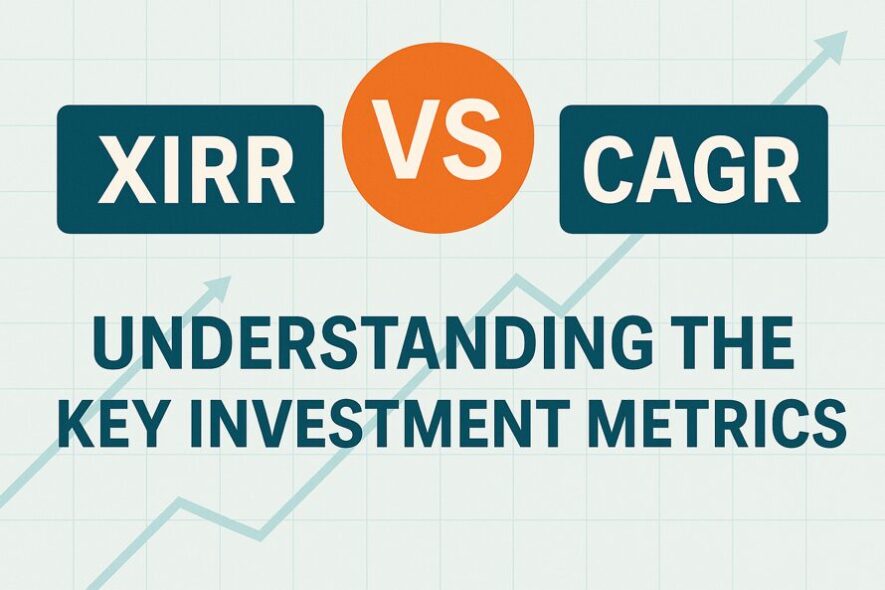SIP Calculator
×XIRR vs. CAGR: Understanding the Key Investment Metrics

Introduction to Investment Return Metrics
Every investor has one big question in mind: “Am I really making money?” The tricky part is that there isn’t a single way to answer it. Numbers tell different stories depending on how they’re calculated. One fact sheet shows a smooth 12% CAGR, another report flashes a 14% XIRR, and suddenly, the same investment looks different depending on the lens.
This is why understanding XIRR vs CAGR matters. Both are measures of investment return, but they aren’t interchangeable. CAGR gives a clean, average annual growth rate for investments that start once and run uninterrupted. XIRR digs deeper, capturing the effect of staggered inflows and outflows, something every SIP investor knows too well.
To break it down, let’s explore both concepts, how they work, and why using the right one matters for investment planning.
What is CAGR (Compound Annual Growth Rate)?
CAGR is one of the most widely used return metrics in the financial investments space. It tells you the annualized growth rate of a single investment over a period, assuming the money grows evenly every year. Of course, markets never really move in straight lines, but CAGR helps simplify the story.
“Start investing with confidence! Explore the best mutual funds and grow your wealth.”
Formula and Calculation Method
The formula is
CAGR = (Ending Value / Beginning Value)^(1 / Number of Years) – 1, which is then multiplied by 100 to express it as a percentage. This formula calculates the average annual rate at which an investment grows over a specific period, accounting for the effects of compounding.
Example:
Suppose you invested ₹1,00,000 in 2018, and by 2023 it grew to ₹1,80,000. The CAGR would be:
18000010000015- 1 = 12.47%
Your money is compounded at about 12.5% each year on average.
Use Cases and Interpretation
CAGR is perfect when you invest once and sit tight, like fixed deposits, bonds, or lump-sum mutual fund investments. It helps compare products side by side: one fund may show 9% CAGR over five years while another shows 12%. It doesn’t reflect market ups and downs, but it offers a simple, comparable growth rate.
What is XIRR (Extended Internal Rate of Return)?
XIRR takes things a step further. It accounts for the timing of every cash flow in and out of your portfolio. Think of it as CAGR’s smarter cousin; it knows that money often enters in parts, sometimes leaves, and needs to reflect that.
Formula and How It Works
The math behind XIRR is complex. It solves for the discount rate that balances all cash inflows and outflows when discounted back to the present. Luckily, you don’t need to calculate it manually; Excel and Google Sheets have a built-in XIRR function.
Real-Life Application in SIPs and Cash Flows
Take SIPs. You invest ₹5,000 each month for three years. At the end of the SIP period, you redeem, say, ₹2,00,000. CAGR won’t give you a meaningful number because contributions were staggered. XIRR, on the other hand, captures each monthly outflow and the final inflow, giving you the actual return percentage.
That’s why mutual fund platforms often show SIP performance in XIRR terms.
Key Differences Between XIRR and CAGR
Both metrics measure returns, but they tell very different stories depending on the investment structure.
Calculation Complexity
CAGR is simple: one starting point, one ending point, one formula. XIRR requires every transaction date, every cash inflow, and every redemption value.
Suitability Based on Investment Type
CAGR works for lump sums and long-term locked deposits. XIRR excels when there are multiple transactions, SIPs, SWPs, top-ups, or partial withdrawals.
Flexibility with Uneven Cash Flows
Markets don’t grow evenly. Salaries come monthly. Business owners add money in chunks. XIRR flexibly adapts to these irregularities, giving a more accurate picture of investment performance.
When to Use XIRR vs When to Use CAGR
Both metrics have their time and place. Knowing when to use each avoids misinterpretation.
Lump Sum Investments vs Systematic Investments
If you invest ₹10 lakh in one go, CAGR explains growth best. If you invest ₹20,000 every month for years, XIRR will be the right metric.
Performance Evaluation of Mutual Funds
Mutual fund fact sheets display both: CAGR for lump-sum examples, XIRR for SIP illustrations. Always check which one you’re looking at before drawing conclusions.
Corporate Finance and IRR Analysis
In corporate finance, businesses evaluate projects with uneven cash inflows and outflows. Here, XIRR (or IRR) is standard. CAGR has little use here since corporate projects rarely have a single start and finish cash flow.
Practical Examples to Compare XIRR and CAGR
Examples bring clarity where formulas may confuse.
Scenario 1: One-Time Investment
You invest ₹1,00,000 in January 2018. By January 2023, it becomes ₹1,61,000. CAGR = 10%. Since it was a one-time investment, XIRR also shows 10%.
Scenario 2: Monthly SIP in a Mutual Fund
You invest ₹5,000 every month for three years, a total of ₹1,80,000. At the end, it grows to ₹2,40,000. CAGR doesn’t apply here. XIRR comes out to roughly 10.7%, reflecting the real performance of your staggered investments.
Tools and Platforms to Calculate XIRR and CAGR
Luckily, investors don’t need to crunch numbers manually.
Excel and Google Sheets
Both have functions to calculate returns. CAGR uses the power formula, while XIRR uses the built-in =XIRR() function. Enter cash flows with dates, and you get results instantly.
Investment Apps and Online Calculators
Most mutual fund apps, broker platforms, and financial websites show XIRR and CAGR by default. This helps avoid misinterpretation and makes returns easy to compare.
Common Mistakes Investors Make When Interpreting Returns
Many investors assume CAGR means the investment earned every year. It doesn’t. It smooths out volatility into one number. Similarly, XIRR can be misleading if cash flow dates are entered incorrectly.
Another mistake is comparing SIP returns (shown in XIRR) against lump sum returns (shown in CAGR). Apples-to-oranges comparisons lead to faulty conclusions.
Conclusion
CAGR and XIRR are two sides of the same coin. CAGR gives a clean, smoothed-out view for single lump sum investments, while XIRR captures the messy, real-world reality of staggered investments.
For everyday investors, knowing XIRR vs. CAGR means interpreting returns correctly. Whether you’re planning SIPs, lump sums, or business cash flows, the right metric ensures you aren’t misled by numbers that look good on paper but don’t tell the full story.
Mastering this difference is like wearing the right lens; it doesn’t change the investment, but it changes how clearly you see it.
FAQs:
What is the main advantage of XIRR over CAGR?
The biggest strength of XIRR is that it accounts for uneven cash flows. Unlike CAGR, which assumes you invested once and held till maturity, XIRR knows that money often comes in parts. If you run a SIP, top up occasionally, or redeem units midway, XIRR reflects the actual annualized return on the money you put in and the money you got back. It gives you a realistic picture instead of a smoothed-out average.
Can XIRR be negative?
Yes, XIRR can turn negative when the value of your investment falls below the amount you initially invested, especially if redemptions occur during a downturn. For example, if you invested ₹60,000 through SIPs and redeemed at ₹55,000, the cash flow math will show a negative XIRR. This doesn’t mean the calculation is wrong; it simply mirrors the fact that the investment generated a loss.
Why does my mutual fund show XIRR instead of CAGR?
Mutual funds prefer showing XIRR when the investment involves multiple transactions, like SIPs. If you’ve been investing monthly, CAGR cannot capture the staggered nature of cash flows. XIRR does that by treating each installment separately. That’s why your fund dashboard highlights XIRR; it’s the metric that best reflects your personal return.
Is XIRR better for SIPs?
Absolutely. SIPs are a classic case of regular, staggered investments. Since each SIP installment has a different start date, CAGR can’t represent the returns accurately. XIRR, on the other hand, handles each date and amount, providing you with the accurate annualized return. That’s why every SIP calculator and mutual fund platform uses XIRR for performance reporting.
How do I calculate XIRR in Excel?
It’s simple. Make a two-column sheet: one for dates, the other for cash flows. Enter investments as negative values (outflows) and redemptions as positive values (inflows). Then use the formula =XIRR (values, dates) in Excel. The result is your annualized XIRR. Google Sheets works the same way, making it easy for any investor to check their returns.
Can I use CAGR for monthly investments?
CAGR isn’t the right tool for SIPs or monthly contributions. It assumes one start and one end value, which ignores the fact that each installment spends a different amount of time in the market. For monthly investments, XIRR is the correct choice. Use CAGR only when you’ve invested a lump sum and held it without adding or withdrawing money.




